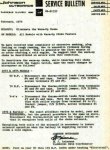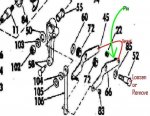Re: 1973 Evinrude 135hp-No Spark...


I had starter rebuilt on friday, installed all the stuff back on motor this morning.
So I got the motor to fire up but shut it down right away,
Dropped in the test tank, need to recharge battery & try again in a bit....
But while going over my stator and such, I noticed that 2 wires a not connected to the terminal block..
I never diconnected it. They come from the head/block one purple and yellow and one purple wire? Any idea what these wires may be for? My guess is the thermo switch?
Would these be left off on purpose to bypass something? Or more likely just forgot to put back on?
I have a wiring diagram it doesn't show a purple/yellow at all but does show a yellow/purple.
The terminal block cover list a purple/yellow and a purple. so I do know where they belong, I think....
I had starter rebuilt on friday, installed all the stuff back on motor this morning.
So I got the motor to fire up but shut it down right away,
Dropped in the test tank, need to recharge battery & try again in a bit....
But while going over my stator and such, I noticed that 2 wires a not connected to the terminal block..
I never diconnected it. They come from the head/block one purple and yellow and one purple wire? Any idea what these wires may be for? My guess is the thermo switch?
Would these be left off on purpose to bypass something? Or more likely just forgot to put back on?
I have a wiring diagram it doesn't show a purple/yellow at all but does show a yellow/purple.
The terminal block cover list a purple/yellow and a purple. so I do know where they belong, I think....






















